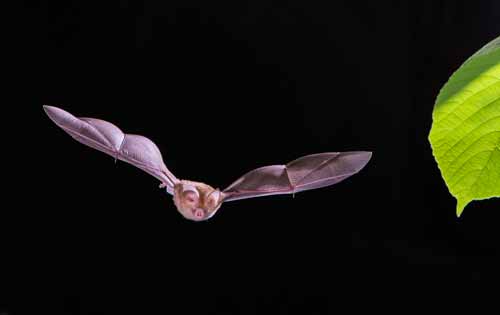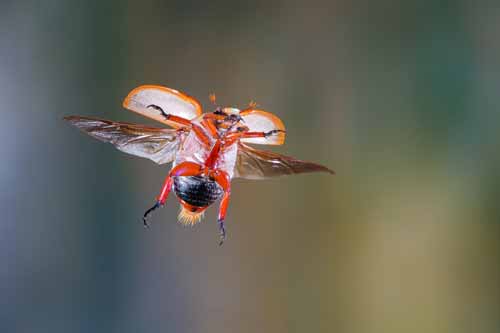High Speed Flash
When can you use this system?
The system that I use for high speed wildlife flash photography requires a subject that is reasonably predictable and flies regularly along an identifiable flight path so that the camera and flashes can be set up. You may need to spend a good deal of time observing and noting the subject’s behaviour as a first step. So, if we have done that, we can now turn our attention to the technical aspects of the task.
A fast exposure
The type of ‘high-speed’ photography that I am going to discuss, requires minimal of no ambient light, as we need the flashes to provide almost all of the light. If the ambient light is too strong, this system will expose the subject with flash light at high speed, and then the ambient light may provide a secondary exposure at a slower speed, that results in ghosting effect - a second blurry image of the subject created by ambient light, imposed over the sharp image that was created by the flash. It’s therefore important to minimize ambient light. If ambient light is quite strong, then it might be better to not run the flashes, but to use a high shutter speed to stop the movement and to photograph in a more conventional fashion.
If using flash in low or nil ambient light, the flashes are obviously going to be the dominant source of light and so it is the flash system that needs to provide the high speed exposure. This can be achieved by setting the flash on manual and dialling down to 1/128th power or thereabouts. There is usually a table in the flash’s instruction manual that tells you what speeds the various power settings run at. Ideally, you need about 1/30,000th second to cover all subjects including insects, but for larger subjects such as birds, you might get away with 1/15,000. It also depends if the subject is flying towards the camera (relatively less perceived movement) or across the field of view. Most modern speedlights allow you to dial in a manual power setting. The amount of light being produced at 1/128th power is quite low, and so perhaps you could use a number of flashes in combination with a higher ISO setting.
Since you are using flash as a dominant light source for the subject, the background is likely to be quite dark. Any attempt to allow ambient light to expose the background is likely to result in ghosting as previously described. You can overcome this by using extra flashes firing at high speed to illuminate the background, or you could use an artificial backdrop that can be exposed at high speed. In either case, you need to prevent ambient light from exposing your image.
Focus and framing
This is where the greatest challenge lies! First, you really need a triggering system to fire the camera. Us humans have a rather slow reaction time and so you need assistance. I normally use an infrared beam system. There are a few of them on the market these days and some can perform a number of functions, aside from IR beam setup (sound triggered, lightning etc).
So you set up the camera and flash(s) and work out the correct exposure. The IR beam triggers the camera and it’s all a go! No, not really! The problem that you still have is shutter lag - the time it takes between the camera receiving the signal to fire, and the actual exposure being made. In many SLR cameras, this can be 1/30th second or so. If your subject is flying at 3 metres/sec, in 1/30th sec it will have travelled 10cm. So where have you focused and framed for the shot? If the subject is flying perfectly at right angles across your frame and its distance to the camera does not change, then you might be ok if you allow enough space to allow for the forward movement when you frame the image, but if it’s coming towards you or at an angle, you have a problem. If you knew that your subject did really fly at 3m/s, then you could calculate its position and focus at that spot, and maybe all would be ok, but many subjects fly at variable rates, so doing the calculation is quite tricky.
Putting it all together
Let’s assume that you have purchased an IR beam trigger and are now wanting to set up for your subject. You have checked your camera specs and indeed, your shutter lag is 1/30th sec. What do you do? Here are a few ideas.
You might be able to set your subject up so that it is just taking off or landing, and flight speed is low. In this case, the shutter lag might be easy enough to deal with by placing the IR beam ahead of where you want the subject to be when it gets photographed. I did this for the Christmas Beetle photo on this page. I added an out-of-focus matt photo as a backdrop and set up two extra flashes to light it up with the same speed as the flashes that are exposing the insect.
Set up at 90 degrees to the line of flight so that the subject does not fly out of focus, or use a wide angled lens and close down the aperture to give yourself a large depth of field to keep the subject in focus.
Do a number of trial runs and set the camera to cover a larger area so that you can see where the subject is positioned when the flashes fire. You could even put a ruler in the background to measure the distance that the subject flies in each test frame. Then frame and focus accordingly, once you know where the subject will be.
If you can work in the dark (bats, owls etc.) then you might be able to connect the flashes directly to the IR beam so that they fly instantaneously when the beam is broken. No shutter leg there! You can then set the camera so that focus is on the IR beam ( and turn AF off after initial focus when setting up) and use a B setting to keep the camera open so that the image is recorded when the flashes fire. Make sure to close off the exposure before another triggering event occurs or you will have multiple exposed subjects in the one frame! This is how I do most of my bat photos.
There are other more advanced options to overcome shutter lag and I use a control box that has quite a few options available. I am not going to describe it in detail because it’s not commercially available and so, interesting as it may be, it’s of no use to you.
As new mirrorless cameras come onto the market and other technological innovations occur, you might find that lag times are going to come down and you might be prepared to buy a camera body specifically for high speed wildlife. I think the latest Sony Alpha 7R III has a shutter lag of 1/50th sec if the half press is already activated. So that’s a step in the right direction. There might be others, but I haven’t done an exhaustive search to look at lag times for all new cameras.
I hope that helps to explain the basics. If it’s given you some incentive to experiment, then it’s all been worthwhile.



